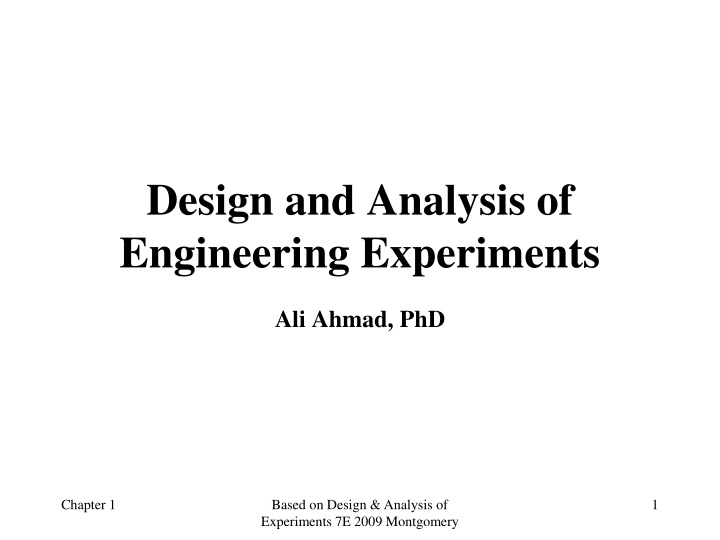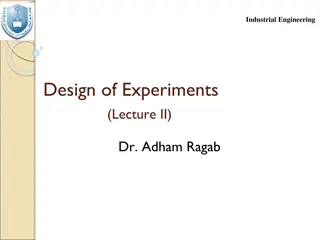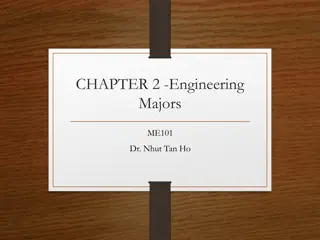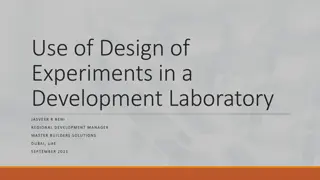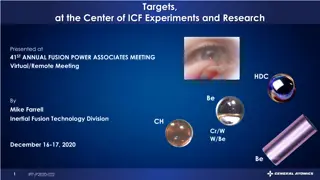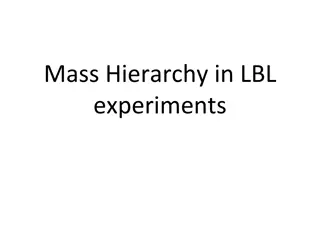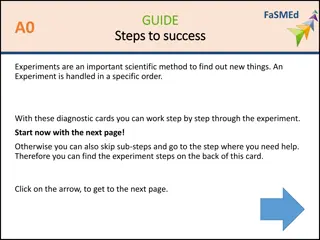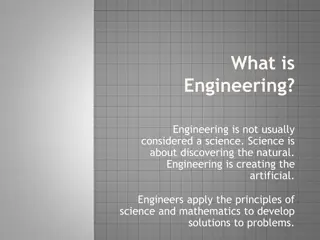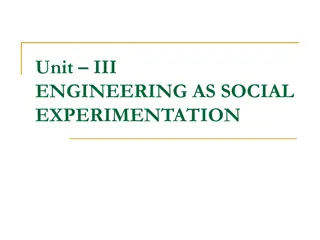Design and Analysis of Engineering Experiments: A Comprehensive Overview
This content delves into the fundamental principles and historical evolution of engineering experiments, highlighting their significance in process characterization, material evaluation, and product development. It explores the impact of notable figures like W.S. Gossett, R.A. Fisher, and George E.P. Box on the field of experimentation. The four eras in the history of Design of Experiments (DOE) are examined, from agricultural origins to modern applications. Key concepts such as randomization, replication, and blocking are discussed to emphasize the importance of well-designed experiments in achieving robustness and reliability in engineering processes.
Download Presentation

Please find below an Image/Link to download the presentation.
The content on the website is provided AS IS for your information and personal use only. It may not be sold, licensed, or shared on other websites without obtaining consent from the author.If you encounter any issues during the download, it is possible that the publisher has removed the file from their server.
You are allowed to download the files provided on this website for personal or commercial use, subject to the condition that they are used lawfully. All files are the property of their respective owners.
The content on the website is provided AS IS for your information and personal use only. It may not be sold, licensed, or shared on other websites without obtaining consent from the author.
E N D
Presentation Transcript
Design and Analysis of Engineering Experiments Ali Ahmad, PhD Chapter 1 Based on Design & Analysis of Experiments 7E 2009 Montgomery 1
Introduction to DOX An experiment is a test or a series of tests Experiments are used widely in the engineering world Process characterization & optimization Evaluation of material properties Product design & development Component & system tolerance determination All experiments are designed experiments, some are poorly designed, some are well-designed Chapter 1 Design & Analysis of Experiments 7E 2009 Montgomery 2
Engineering Experiments Reduce time to design/develop new products & processes Improve performance of existing processes Improve reliability and performance of products Achieve product & process robustness Evaluation of materials, design alternatives, setting component & system tolerances, etc. Chapter 1 Design & Analysis of Experiments 7E 2009 Montgomery 3
Four Eras in the History of DOX The agricultural origins, 1908 1940s W.S. Gossett and the t-test (1908) R. A. Fisher & his co-workers Profound impact on agricultural science Factorial designs, ANOVA The first industrial era, 1951 late 1970s Box & Wilson, response surfaces Applications in the chemical & process industries The second industrial era, late 1970s 1990 Quality improvement initiatives in many companies Taguchi and robust parameter design, process robustness The modern era, beginning circa 1990 Chapter 1 Design & Analysis of Experiments 7E 2009 Montgomery 4
George E. P. Box R. A. Fisher (1890 1962) Chapter 1 Design & Analysis of Experiments 7E 2009 Montgomery 5
The Basic Principles of DOX Randomization Running the trials in an experiment in random order Notion of balancing out effects of lurking variables Replication Sample size (improving precision of effect estimation, estimation of error or background noise) Replication versus repeat measurements? (see pages 12, 13) Blocking Dealing with nuisance factors Chapter 1 Design & Analysis of Experiments 7E 2009 Montgomery 6
Strategy of Experimentation Best-guess experiments Used a lot More successful than you might suspect, but there are disadvantages One-factor-at-a-time (OFAT) experiments Sometimes associated with the scientific or engineering method Devastated by interaction, also very inefficient Statistically designed experiments Based on Fisher s factorial concept Chapter 1 Design & Analysis of Experiments 7E 2009 Montgomery 7
Factorial Designs In a factorial experiment, all possible combinations of factor levels are tested The golf experiment: Type of driver Type of ball Walking vs. riding Type of beverage Time of round Weather Type of golf spike Etc, etc, etc Chapter 1 Design & Analysis of Experiments 7E 2009 Montgomery 8
Factorial Design Chapter 1 Design & Analysis of Experiments 7E 2009 Montgomery 9
Chapter 1 Design & Analysis of Experiments 7E 2009 Montgomery 10
Factorial Designs with Several Factors Chapter 1 Design & Analysis of Experiments 7E 2009 Montgomery 11
Chapter 1 Design & Analysis of Experiments 7E 2009 Montgomery 12
Factorial Designs with Several Factors A Fractional Factorial Chapter 1 Design & Analysis of Experiments 7E 2009 Montgomery 13
Planning, Conducting & Analyzing an Experiment 1. Recognition of & statement of problem 2. Choice of factors, levels, and ranges 3. Selection of the response variable(s) 4. Choice of design 5. Conducting the experiment 6. Statistical analysis 7. Drawing conclusions, recommendations Chapter 1 Design & Analysis of Experiments 7E 2009 Montgomery 14
Planning, Conducting & Analyzing an Experiment Get statisticalthinking involved early Your non-statistical knowledge is crucial to success Pre-experimental planning (steps 1-3) vital Think and experiment sequentially (use the KISS principle) See Coleman & Montgomery (1993) Technometrics paper + supplemental text material Chapter 1 Design & Analysis of Experiments 7E 2009 Montgomery 15
